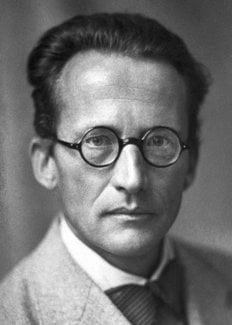Erwin Schrodinger - The Father Of Quantum Mechanics and The Father Of Quantum Physics
https://www.nobelprize.org/prizes/physics/1933/schrodinger/biographical/
Erwin Schrödinger
Biographical
 Erwin Schrödinger
was born on August 12, 1887, in Vienna, the only child of Rudolf
Schrödinger, who was married to a daughter of Alexander Bauer, his
Professor of Chemistry at the Technical College of Vienna.
Erwin Schrödinger
was born on August 12, 1887, in Vienna, the only child of Rudolf
Schrödinger, who was married to a daughter of Alexander Bauer, his
Professor of Chemistry at the Technical College of Vienna.
Erwin’s father came from a Bavarian family which generations before had settled in Vienna. He was a highly gifted man with a broad education. After having finished his chemistry studies, he devoted himself for years to Italian painting. After this he took up botany, which resulted in a series of papers on plant phylogeny.
Schrödinger’s wide interests dated from his school years at the Gymnasium, where he not only had a liking for the scientific disciplines, but also appreciated the severe logic of ancient grammar and the beauty of German poetry. (What he abhorred was memorizing of data and learning from books.)
From 1906 to 1910 he was a student at the University of Vienna, during which time he came under the strong influence of Fritz Hasenöhrl, who was Boltzmann’s successor. It was in these years that Schrödinger acquired a mastery of eigenvalue problems in the physics of continuous media, thus laying the foundation for his future great work. Hereafter, as assistant to Franz Exner, he, together with his friend K. W. F. Kohlrausch, conducted practical work for students (without himself, as he said, learning what experimenting was). During the First World War he served as an artillery officer.
In 1920 he took up an academic position as assistant to Max Wien, followed by positions at Stuttgart (extraordinary professor), Breslau (ordinary professor), and at the University of Zurich (replacing von Laue) where he settled for six years. In later years Schrödinger looked back to his Zurich period with great pleasure – it was here that he enjoyed so much the contact and friendship of many of his colleagues, among whom were Hermann Weyl and Peter Debye. It was also his most fruitful period, being actively engaged in a variety of subjects of theoretical physics. His papers at that time dealt with specific heats of solids, with problems of thermodynamics (he was greatly interested in Boltzmann’s probability theory) and of atomic spectra; in addition, he indulged in physiological studies of colour (as a result of his contacts with Kohlrausch and Exner, and of Helmholtz’s lectures). His great discovery, Schrödinger’s wave equation, was made at the end of this epoch-during the first half of 1926.
It came as a result of his dissatisfaction with the quantum condition in Bohr’s orbit theory and his belief that atomic spectra should really be determined by some kind of eigenvalue problem. For this work he shared with Dirac the Nobel Prize for 1933.
In 1927 Schrödinger moved to Berlin as Planck’s successor. Germany’s capital was then a centre of great scientific activity and he enthusiastically took part in the weekly colloquies among colleagues, many of whom “exceeding him in age and reputation”. With Hitler’s coming to power (1933), however, Schrödinger decided he could not continue in Germany. He came to England and for a while held a fellowship at Oxford. In 1934 he was invited to lecture at Princeton University and was offered a permanent position there, but did not accept. In 1936 he was offered a position at University of Graz, which he accepted only after much deliberation and because his longing for his native country outweighed his caution. With the annexation of Austria in 1938, he was immediately in difficulty because his leaving Germany in 1933 was taken to be an unfriendly act. Soon afterwards he managed to escape to Italy, from where he proceeded to Oxford and then to University of Ghent. After a short stay he moved to the newly created Institute for Advanced Studies in Dublin, where he became Director of the School for Theoretical Physics. He remained in Dublin until his retirement in 1955.
All this time Schrödinger continued his research and published many papers on a variety of topics, including the problem of unifying gravitation and electromagnetism, which also absorbed Einstein and which is still unsolved; (he was also the author of the well-known little book “What is Life?”, 1944). He remained greatly interested in the foundations of atomic physics. Schrödinger disliked the generally accepted dual description in terms of waves and particles, with a statistical interpretation for the waves, and tried to set up a theory in terms of waves only. This led him into controversy with other leading physicists.
After his retirement he returned to an honoured position in Vienna. He died on the 4th of January, 1961, after a long illness, survived by his faithful companion, Annemarie Bertel, whom he married in 1920.
This autobiography/biography was written at the time of the award and first published in the book series Les Prix Nobel. It was later edited and republished in Nobel Lectures. To cite this document, always state the source as shown above.
https://www.ourbiography.com/erwin-schrodinger/
Erwin Schrödinger
Erwin Schrödinger was a Nobel Prize-winning Austrian physicist whose groundbreaking wave equation changed the face of quantum theory.
Synopsis
Born on August 12, 1887, in Vienna, Austria, Erwin Schrödinger went on to become a noted theoretical physicist and scholar who came up with a groundbreaking wave equation for electron movements. He was awarded the 1933 Nobel Prize in Physics, along with British physicist P.A.M. Dirac, and later became a director at Ireland's Institute for Advanced Studies. A published author with works like What Is Life?, he died on January 4, 1961, in his home city.
Background
Erwin Schrödinger was born on August 12, 1887, in Vienna, Austria, the only child of botanist and oil cloth factory owner Rudolf Schrödinger and Georgine Emilia Brenda, daughter of Alexander Bauer, Rudolf's professor of chemistry at the Technical College of Vienna (Technische Hochschule Vienna). Erwin was taught at home by private teachers until he was 11 years old, and then attended Vienna's Akademisches Gymnasium. He went on to enter the University of Vienna, where he focused primarily on the study of physics and was strongly influenced by another young physicist, Fritz Hasenöhrl, and graduated with a Ph.D. in physics in 1910. Afterward, he worked for a few years at the institution as an assistant, but was drafted into World War I in 1914, serving with Austro-Hungarian military forces in Italy as an artillery officer.
Upon returning to civilian life, Schrödinger married Annemarie Bertel in 1920. He also took on a number of faculty/staff positions at places like the University of Stuttgart, the University of Jena and the University of Breslau, before joining the University of Zurich in 1921.
His Own Wave Equation
Erwin Schrödinger's tenure as a professor at Zurich over the next six years would prove to be one of the most important periods of his physics career. Immersing himself in an array of theoretical physics research, Schrödinger came upon the work of fellow physicist Louis de Broglie in 1925. In his 1924 thesis, De Broglie had proposed a theory of wave mechanics. This sparked Schrödinger's interest in explaining that an electron in an atom would move as a wave. The following year, he wrote a revolutionary paper that highlighted what would be known as the Schrödinger wave equation.
Following the atomic model of Niels Bohr and a thesis from de Broglie, Schrödinger articulated the movements of electrons in terms of wave mechanics as opposed to particle leaps. He provided a mode of thought to scientists that would become accepted and incorporated into thousands of papers, thus becoming an important cornerstone of quantum theory. Schrödinger made this discovery in his late 30s, with most theoretical physicists sharing groundbreaking finds in their 20s.
Wins Nobel Prize
In 1927, Schrödinger left his position at Zurich for a new, prestigious opportunity at the University of Berlin, where he met Albert Einstein. He held this position until 1933, opting to leave upon the rise of Adolf Hitler's Nazi Party and the related persecution of Jewish citizens. Shortly after joining the faculty of Oxford University in England, Schrödinger learned that he had won the 1933 Nobel Prize in Physics, sharing the award with another quantum theorist, Paul A.M. Dirac. In his Nobel Prize acceptance speech, Schrödinger stated that his mentor, Hasenöhrl, would be accepting the award if he hadn't died during World War I.
Following a three-year stay at Oxford, Schrödinger traveled and worked in different countries, including in Austria at the University of Graz. In 1939, he was invited by Irish Prime Minister Eamon de Valera to work at the Institute for Advanced Studies in Dublin, Ireland, heading its School for Theoretical Physics. He remained in Dublin until the mid-1950s, returning in 1956 to Vienna, where he continued his career at his alma mater.
Books and Final Years
In terms of his writing, Schrödinger published the influential book What Is Life?, his attempt to link quantum physics and genetics, in 1944. He was also versed in philosophy and metaphysics, as evidenced in Nature and the Greeks (1954), which looked at ancient belief systems and inquiries; and his final book, My View of the World (1961), inspired by the Vedanta and exploring belief in a unified consciousness.
Schrödinger died on January 4, 1961, in his hometown of Vienna. A 1989 book on his life was written by professor Walter J. Moore—Schrödinger: Life and Thought.
Erwin Schrodinger
Nobel Prize winner Erwin Schrödinger established the wave mechanics formulation of quantum mechanics, which portrayed electrons as waves, spread out rather than in any given location. Schrödinger showed that his wave mechanics and Werner Heisenberg’s matrix mechanics, although superficially different, were mathematically equivalent. In his later years, Schrödinger became unhappy with quantum mechanics and is famous for the Schrödinger’s cat thought experiment, in which he attempted to show the absurdity of the Copenhagen interpretation of quantum mechanics.
Schrödinger’s 1944 book What is Life?, although not entirely original, had a profound effect on the future of genetics and molecular biology. Schrödinger wrote that the gene was an aperiodic crystal – a code script for life. His book inspired a number of scientists – including three of the main players in the discovery of DNA’s structure – Francis Crick, James Watson and Maurice Wilkins – to pursue research in that field.
|
|


Comments
Post a Comment